Jet Moon
Between 2018-2019 Jet Moon created Resilient and Resisting, a collaborative storytelling and oral history project that collects stories from people at the intersection of disability, queerness, kink, sex work, and survivorship. Currently, Jet is compiling a book version of Resilient and Resisting, to present the collected stories, photographs, and archive material as a tool for community sharing events. The original project was funded by The Heritage Lottery Fund. In the following post, Jet Moon shares their approach to this project.
*
I’m aware I do a very ‘incorrect’ form of oral history, when compared with, for example, The British Library who describe their methods as ‘rigorous’. Resilient and Resisting challenges notions of correctness. The stories in Resilient and Resisting are not verbatim texts, but instead, a creative collaborative process with interviewees, transforming oral history interviews into narrative stories. The person being interviewed participates in a storytelling process with me. That process is often healing, a deep listening and acknowledgement of our shared marginalised experience. After writing a draft, I share this with the person I interviewed. Some people correct details, sometimes we re-write together, other times people are just happy with the result.
With support from Bishopsgate Institute Special Collections and Archive, Hackney Museum, MayDay Rooms, and Arcola Theatre, these stories were first presented in a series of workshops and reading events alongside archive materials or museum displays. These events were a space for communities and individuals to hear themselves reflected in a powerful respectful way. To have their stories presented as valuable historical documents.
These events would feature a small collection of the stories curated around one of the core themes: disability, queerness, kink, sex work, or survivorship. As all the stories contain three or more of these topics, a process of overlap and gaps between stories occurs. This creates a dynamic space of richness and interchange, as individuals listen to their common ground alongside the differences.
Below are two accounts of presenting the stories alongside archival materials: they demonstrate the function of overlapping, and how these themes brought people together.
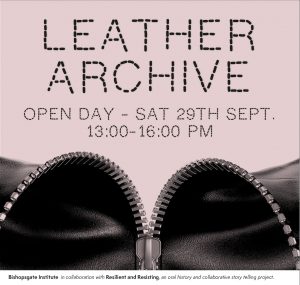
Designed by Ola Podgorska of Fierce Love design
Leather and Fetish Archive Open Day with readings: Saturday, 29th September 2018, in collaboration with Bishopsgate Institute Special Collections and Archives.
Housed in a grand Victorian building close to Liverpool Street Station, when the volunteers arrived at the institute they would ask ‘Is it here? Are we in here?’ In my experience as an SM Dyke/a queer, I’m more used to parties in basements that stink of piss (and we had to fight for that!). It’s amazing to see our kink culture in this setting.
During the event, people pored over the books, pamphlets, photographs, drawings, boxes of memorabilia, club patches, and badges. People read aloud to each other – for a while I joined a group who were reading out the gay personal ads from a small magazine printed in Leytonstone in the 1970s. They were sweet, pervy, queer, full of desire and longing, pre-Internet, no instant hook-ups, no apps!
‘Sorry the material here is all mostly men’, whispers the archivist, ‘it’s what we’ve got.’
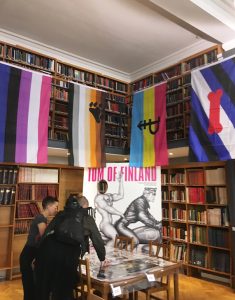
Credit: Cath LeCouteur
At 2pm, we gather for the story readings, surrounded by the antique beauty of the Library, the stained-glass dome overhead. A large-scale recreation of ‘The Last Supper’ featuring Leather Men seated at a table draped with the Leather Pride flag hangs behind us.
The archivist reads first from an editorial from the 1977 copy of the MSC Leather Men’s newsletter, which begins: ‘Not for your Maiden Aunts or Grandmothers…’ I chose the article – while it is sweetly nostalgic, it also provides a great counterpoint to the Resilient and Resisting stories.
Our first reader follows: ‘It started after watching some porn and I had just cum like a train.’ A story that ranges across kink, queerness, childhood sexual abuse and trauma, mental health, and community work. One of a triad of stories, that additionally span gender identity, disability, activism, the lesbian sex wars, domestic violence, sexual education, and survivorship. The stories break stereotypes and demonstrate the breadth of our shared history, in surviving stigma and creating social change.
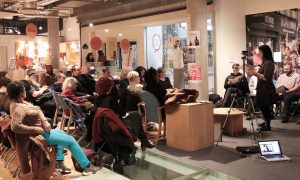
Credit: Cath LeCouteur
My lasting impression of the day was of the participants’ openness to each other: some were kinky, not kinky, curious, new to the scene, others were old to the scene, from different generations, Gay, Pan, Dykes, WLTI. There was a feeling of sharing the space together, feeling what community can be – an ability to be open and discuss, to listen to each other and explore, valuing our histories.
Access a more in-depth report on the Leather and Fetish Archive Day Event
‘Fighting for Space, love and loss’ 28th February 2019 at the Hackney Museum.
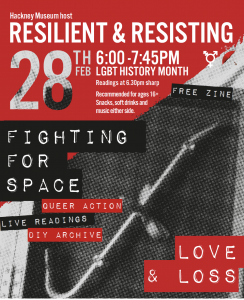
As part of this event, there was a call for people to contribute objects to a temporary exhibition for the duration of the evening: ‘Come and celebrate Queer Action past and present by taking up space in the Hackney Museum. What isn’t allowed to be on display? What objects would you contribute and caption to tell a tale of Hackney Queerness?’
In a project about stigma and social change, many conversations have questioned structures of exclusion, and even the concept of who ‘the general public’ were. When people were invited to contribute the most common question was ‘What counts as an object?’ It was very closely followed by ‘I don’t know what I have that counts as history.’
Museum staff emptied cases and made space available so that nestled among the permanent collection were items contributed by the community for this event: a giant uterus costume from Transfabulous transgender festival of the arts, protest signs, photographs, and memorabilia representing protests – decades apart – by the Lesbian Avengers in the 1980s and East London Strippers Collective in 2008, both of which had taken place outside the Hackney Town Hall next door to the museum. Core Arts Men’s GBT Mental Health Group set out objects in a shared corner display case. Mounted on a wall next to a portrait of some historical figure is the ‘magical crowbar’ from A.S.S. Advisory Service for Squatters, and a list of the crowbar’s attributes, including ‘the power to make padlocks turn to dust, and bailiffs and cops to call in sick.’
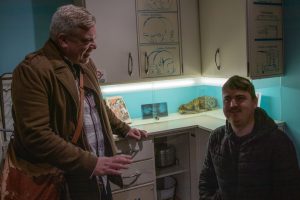
Credit: Cath LeCouteur
The exhibition and readings showed our complex community: sex-working queers, squatter queers, kinky queers, queers who are tired of racism in the scene, Crip queers, traveller queers, activist queers, celebrating what we’ve loved and what we’ve lost, what we’re still fighting for.

Credit: Cath LeCouteur
Around 20 members of the Project Indigo youth group are present at ‘Fighting for Space, love and loss’. Sitting up front asking questions, they are focused and engaged. Many of us older folk ask each other ‘I wonder what it is like hearing these histories at such a young age?’ We are enormously affected by their presence, as it reflects the lack we experienced, we grew up in times of illegality, Section 28, and other prohibitions.
This event was one of my favourites, and around 50 people attended. Some took part by installing and captioning their own objects within the museum. Everyone sat together, listening to stories read by our readers, and following along in the zine. The atmosphere was lively and intimate at the same time.
Access a more in-depth report on the ‘Fighting for Space, love and loss’ event
I have lived long enough as a multiply marginalised person to know that sharing specific commonalities of experience does not always produce unity. Instead, often the opposite occurs with groups splitting into smaller and smaller factions. Resilient and Resisting took a different approach by asking people to think between the gaps of shared experience and to accept difference. Placing our contemporary stories in a historical and political context, we showed that our struggles don’t exist in a vacuum, and similar issues have been fought for repeatedly. It demonstrated that we may not always feel resilient, but the resistant act of living and gathering with others can bring about change in society.
Jet Moon is a multi-disciplinary artist who writes, performs, and collaborates on fierce work for radical social change. Collaborating for many years with the LGBTIQ, kink, sex worker, disability, and survivor communities they belong to, creating intimate spaces of sharing, visibility and resistance.

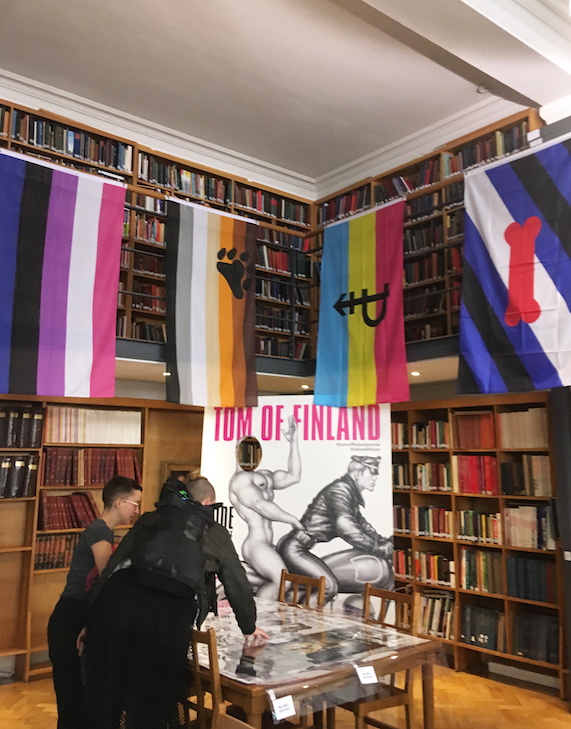
Published by